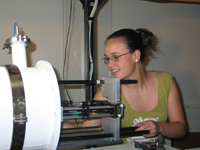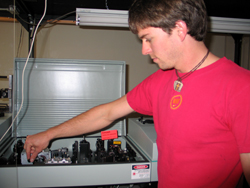Students Design Erosion Sensor for Deep Space Travel
 |
|
Design project team member, Ellen Zwickl, works on the laser-based sensor.
|
Students in the engineering program at CSU are looking at how to propel spacecrafts deeper into space. Scott Domingue, Stan Nielsen, Kevin Troyer, and Ellen Zwickl worked alongside Dr. Azer Yalin, associate professor of mechanical engineering, on a senior design project creating laser-based sensors. These sensors will be used to detect and measure erosion of satellite and spacecraft thrusters. Sputter erosion - the process by which bombarding ions cause the ejection of material from a surface – is an unavoidable effect of great importance in electric propulsion thrusters.
"Typically it’s really hard to measure the erosion rate because it’s a very slow process," says mechanical engineering student Scott Domingue, "so we’ve developed a laser sensor to try to quantify how quickly these thrusters will erode." The sensor will be integrated with laser diagnostic approaches that Professor Yalin’s research group has been developing.
 |
|
Scott Domingue adjusts the laser equipment.
|
Sputter erosion is responsible for many thruster failure mechanisms and ultimately limits thruster lifetime, which is typically thousands of hours of thrust. Looking for better and faster ways to characterize the lifetime of these thrusters, Yalin and his research team have developed a practical means of performing accelerated thruster lifetime diagnostics. Cavity Ring-Down Spectroscopy (CRDS) is an ultra-sensitive, laser-based technique that Yalin’s group is implementing to measure the erosion of thruster materials with high sensitivity in real time.
It was the students' task to work with and improve CRDS for their specified project. To increase the sensitivity in the CRDS measurements, they designed and fabricated a new vacuum system and optical cavity configuration. Using these tools, the students began their experimentation using pulsed cavity ring-down spectroscopy of sputtered aluminum. Following their trials with pulsed CRDS, they began to work with continuous cavity ring-down spectroscopy, a much more advanced technique.
The students presented their work at CSU’s E-Days and at a space symposium in Boulder, where they won first place in their session. The senior design team was partially supported by the Colorado Space Grant Consortium.